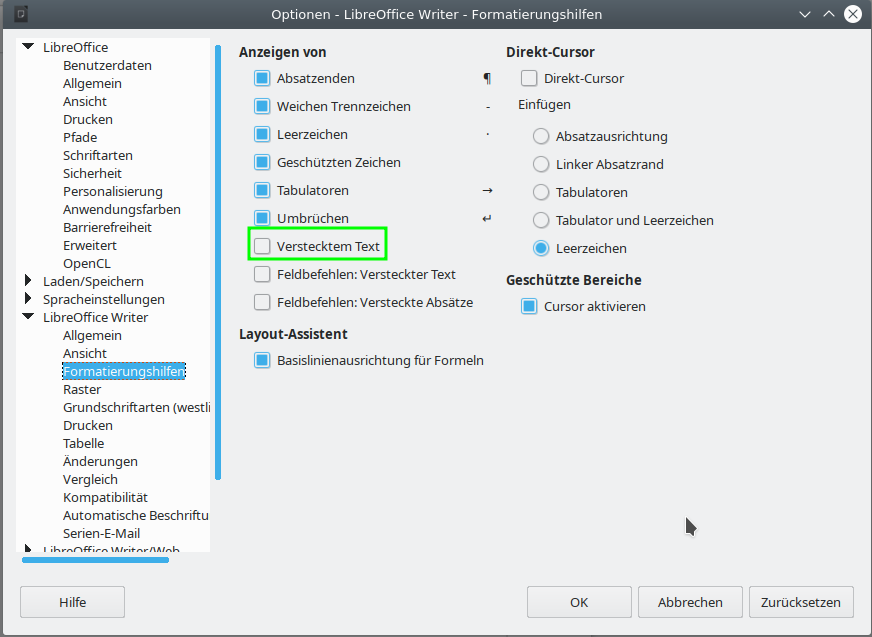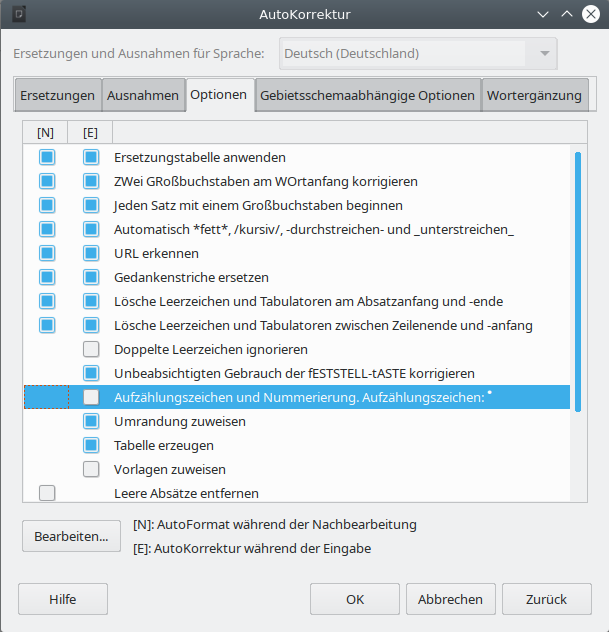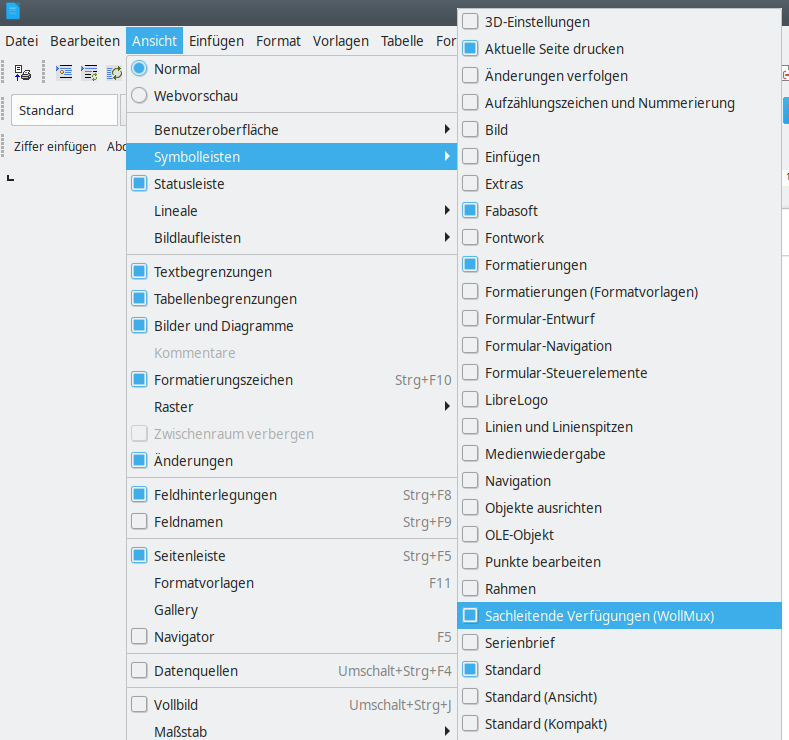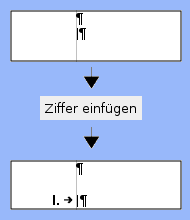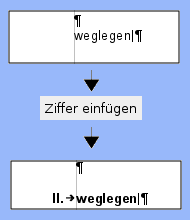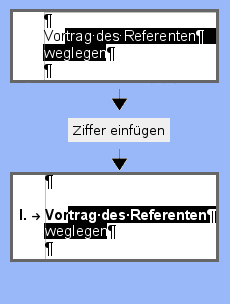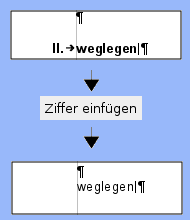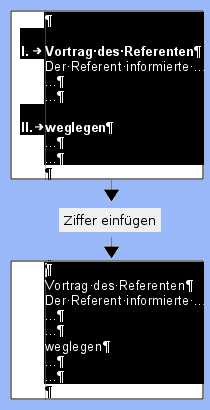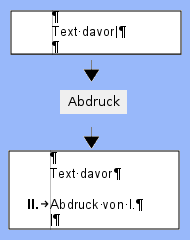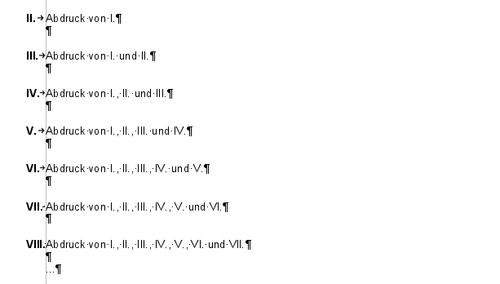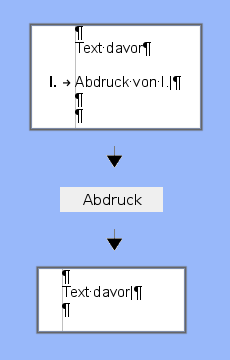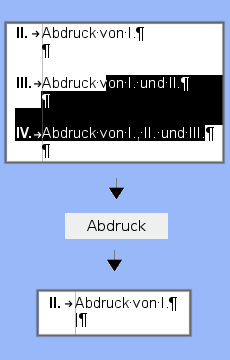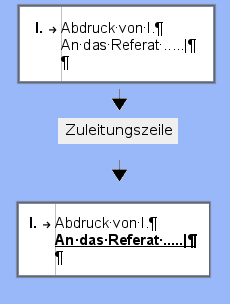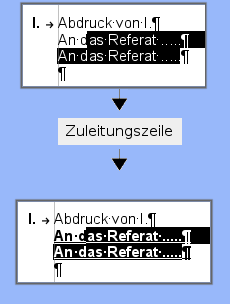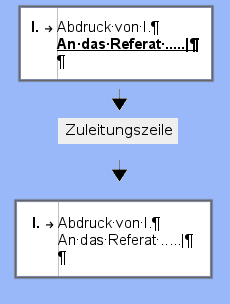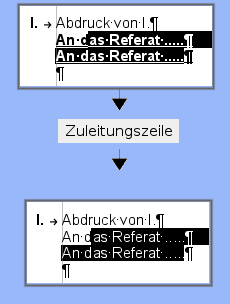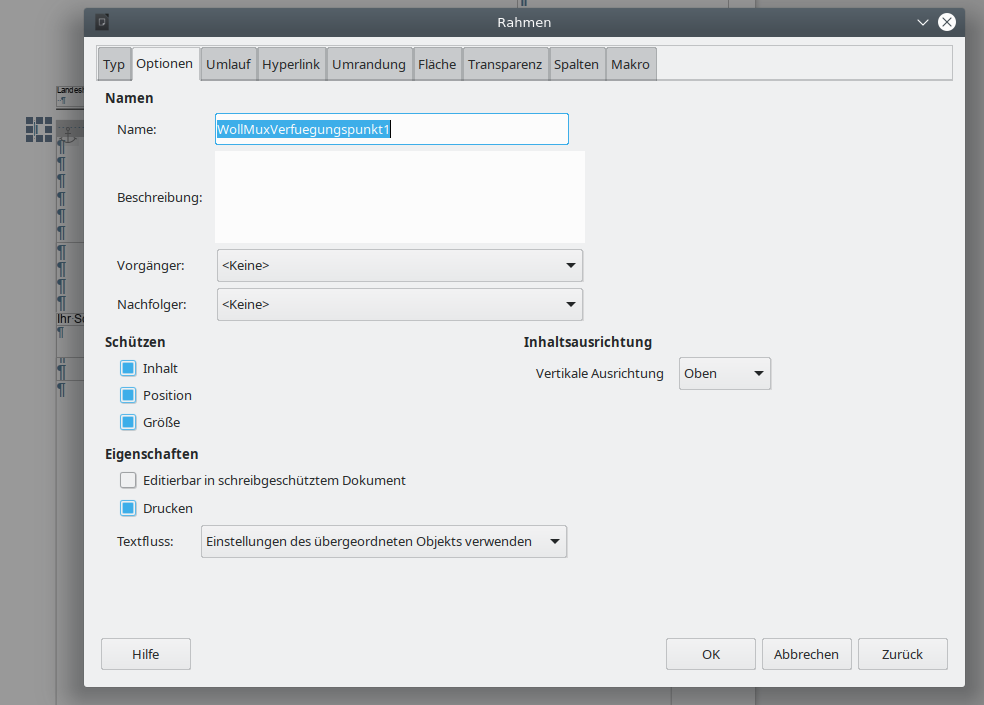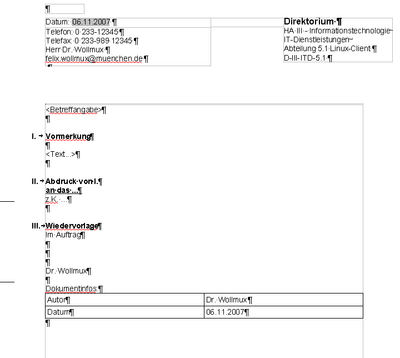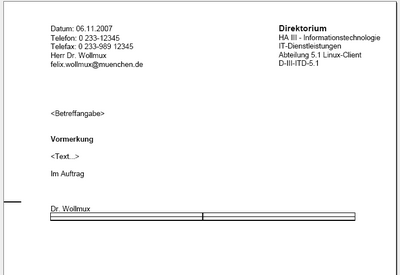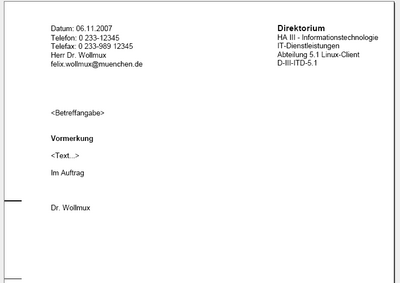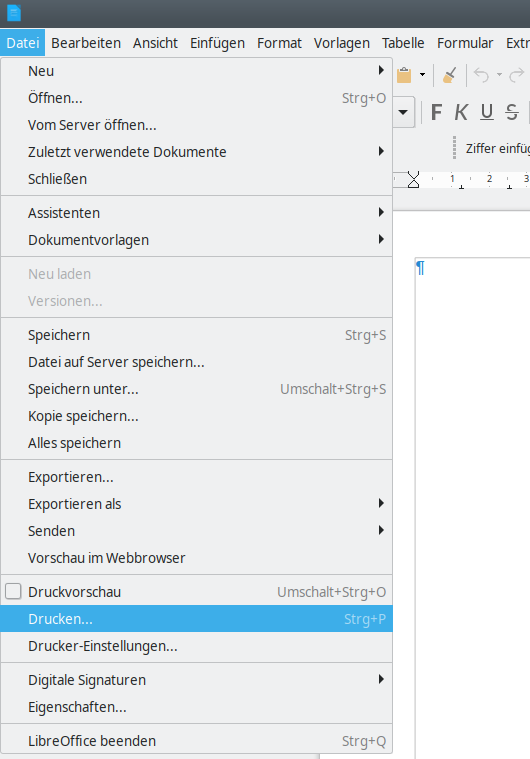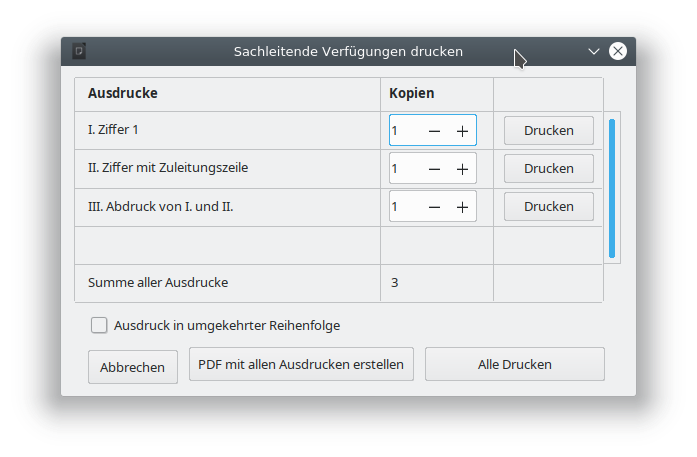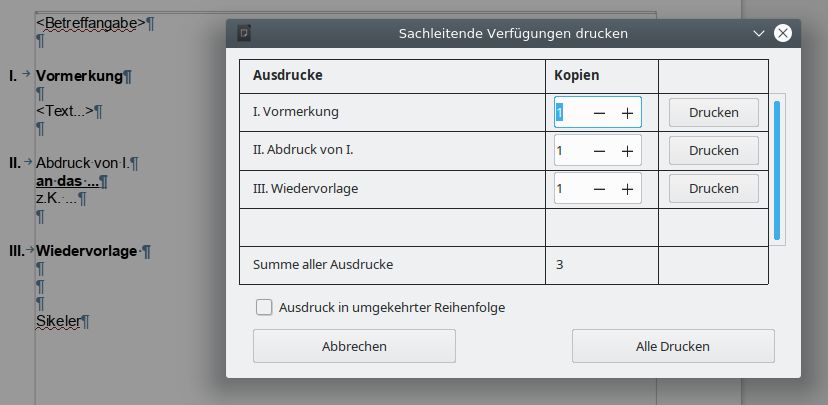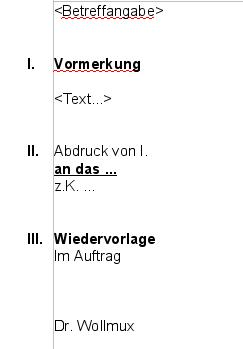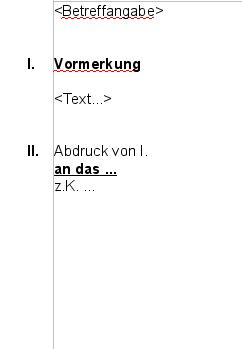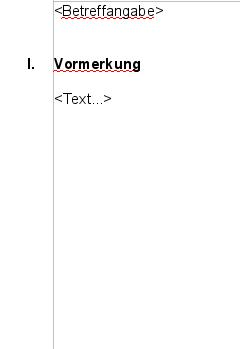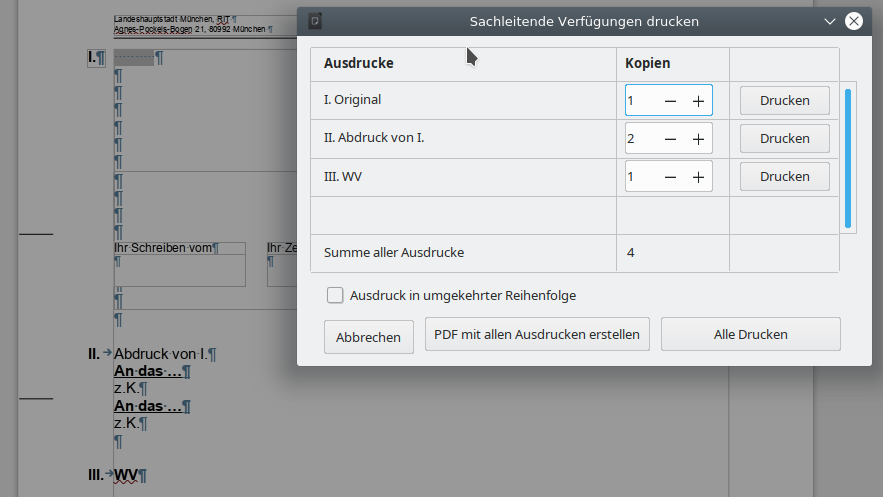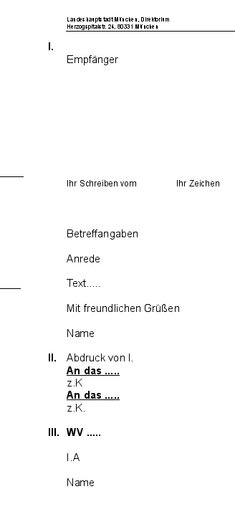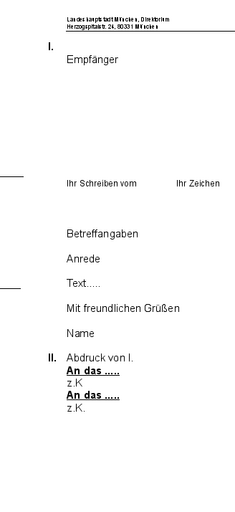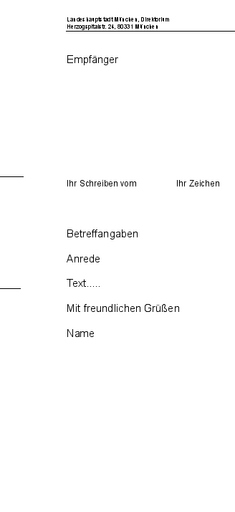Documentation/WollMux/Content based directives
TDF LibreOffice Document Liberation Project Community Blogs Weblate Nextcloud Redmine Ask LibreOffice Donate
Content based directives
This article describes how to use the Content based directives help provided by WollMux from a user perspective.
Prerequisites for using Content based directives
Before you can use WollMux to create Content based directives, the following prerequisites must be met:
Settings in LibreOffice
The following settings must be set in LibreOffice in order to work smoothly with Content based directives:
- Under Tools→Options.../LibreOffice Writer/Formatting Aids the display of hidden text must be turned off. When printing, WollMux uses the ability in LibreOffice to hide text areas. In order for LibreOffice to correctly calculate the number of total pages when printing, the hidden areas must not be displayed. This option is already set correctly on the base client. * Under Tools->AutoCorrect>AutoCorrect-Options/Options the option "Apply numbering - Symbol:*" must be disabled. The disposition points of Content based directives start with Roman numerals. To prevent LibreOffice from interpreting these digits as enumerations, this option must be disabled. On the base client this option is already set correctly. Furthermore, WollMux automatically disables this option when working with Content based directives for the first time.
The LibreOffice Writer toolbar "Content based directives"
The "Content based directives" toolbar must be activated in Writer in the menu "View" → Toolbars → Content based directives. The new toolbar "Content based directives" contains buttons "Insert figure", "Imprint" and "Lead line". Furthermore, five buttons for creating the blocks for print control are included: "Always print", "Not original", "Original only", "Draft only" and "Impressions only".
The following is a more detailed description of each of the toolbar buttons:
Insert or remove items
The following three buttons can be used to insert or remove elements of the Content based directives.
The button "Insert digit"
Insert new digits
Using the "Insert Digit" button, it is possible to insert a Roman numeral that can be used to set another disposition point in the document. The new number is one higher than the previous digits already present in the document. If the newly set reorder point is followed by other reorder points, these are renumbered so that the total numbering of all reorder points is correct again.
The following graphics demonstrate how "Insert digit" works:
|
The cursor is at the beginning of a line. After pressing "Insert digit", a new digit is set at the left margin and you can start writing the heading for this disposal point. |
The cursor is placed at another position in the current line (here at the end): A digit is added to the current line and it is formatted as a heading line of an disposal point. |
The cursor marks an entire area: the first line of the mark is given a new Roman numeral and formatted as a disposition point. |
Delete existing digits
Similarly, the button can be used to remove existing disposal points. If the cursor is on a paragraph that is already a heading of a disposal point, the Roman numeral at the beginning of the heading line is deleted and the style of this paragraph is reset to "body text".
|
The cursor is already on a heading for a disposal point. The Roman numeral is removed again and the paragraph is set back to "body text". |
The cursor marks a whole area in which already headings for disposal points are contained: All disposition points touched by the selection are reset to "continuous text". |
The "Impression" button
Insert new impression
Using the Impression button, it is possible to insert an disposition point with the content "Impression of I.[...]". The new disposition point is always inserted after the paragraph where the cursor is located.
|
Pressing "Impression" inserts a new impression line and places the cursor in the following line after "Impression of...". |
The numbering of the remaining disposal points is thereby automatically adjusted as in The "Insert digit" button. In the case of already existing impressions, the text "Impression of I.[...]" is thereby also adapted in such a way that all predecessors are always listed. After the automatically generated text "Impression of I., ..." any free text can be entered, e.g. "with attachments", which remains intact during the adjustment of the Roman numerals. If, for example, another disposal point is inserted before the heading "Impression of I. with attachments", the impression is renamed "Impression of I. and II. with attachments".
The following example illustrates how the automatic naming of the impression lines works. It was created by pressing "Impression" several times:
Remove existing impression
Similarly, the button can be used to remove existing impressions.
|
The cursor is already on an impression. The impression is removed again. |
The cursor marks a whole area in which already impressions are contained: All impressions that are touched by the mark are deleted. |
The "Feed line" button
Insert new feed line
Using the feed line button, it is possible to mark paragraphs as feed lines that are currently selected or contain the cursor. Each paragraph of the type feed line leads to another expression. A supply line can also be a real address with street, house number and postal code. For multiline feed line entries it is mandatory to use an line break (Shift-Enter or Insert/Manual Break/Line Break), no paragraph break (simply pressing the Enter key), otherwise the number of printed copies will be calculated incorrectly.
|
Pressing Feed Line makes the line where the cursor is located the feed line and when printed, a printout is generated. |
By pressing Feed line all lines that are marked are made the feed line and when printing a printout is generated per paragraph. |
Delete existing feed line
If the paragraph is already defined as a feed line, it will be cancelled (and the paragraph format reset to continuous text) after pressing the button.
|
Pressing feed line resets the line where the cursor is to continuous text. |
By pressing on feed line all the line that are marked are reset to continuous text. |
The buttons to control the printing of individual blocks
"Always print" button
The "Always Print" button can be used to designate a selected block that will always be printed, even if text areas under a disposition point heading are otherwise hidden.
Insert "always print" block
Remove "always print" block
To remove an "always print" block mark the corresponding text with the mouse and press the "always print" button again:
If a background color is defined for this print block in the WollMux configuration, the print block is highlighted with the color defined there to visually distinguish the block and make it easier to locate. You can ask your system administrator whether such a color is defined. When printing a corresponding document, the background color not is also printed.
Button "Not in original"
With the button "Not in original" a marked block can be marked which will be printed in all printouts except the original (the original is always the version in which all Roman numerals including I. are hidden).
Marking and unmarking a block works in the same way as the "Always print" block by pressing the corresponding button.
If a background color is defined in the WollMux configuration for this print block, the print block is highlighted with the color defined there to visually distinguish the block and make it easier to locate. You can ask your system administrator whether such a color is defined. When printing a corresponding document, the background color is not printed with it.
Button "Original only"
With the button "Original only" a marked block can be marked which is printed exclusively in the original (the original is always the version in which all Roman numerals including I. are hidden).
Marking and unmarking a block works in the same way as the "Always print" block by clicking the corresponding button.
If a background color is defined in the WollMux configuration for this print block, the print block is highlighted with the color defined there to visually distinguish the block and make it easier to locate. You can ask your system administrator whether such a color is defined. When printing a corresponding document, the background color is not printed with it.
Button "Draft only"
The "Draft only" button can be used to mark a block that is only printed as a draft. Draft is the printout that contains all Content based directives.
Marking a block and unmarking a block works in the same way as the "Always print" block by pressing the corresponding button.
If a background color is defined in the WollMux-configuration for this print block, the print block is highlighted with the color defined there to visually distinguish the block and make it easier to locate. You can ask your system administrator whether such a color is defined. When printing a corresponding document, the background color is not printed with it.
Button "Imprints only"
With the button "Impressions only" a marked block can be marked which will be printed in impressions only. All printouts except the first (the original) and the last (the draft) are called impressions.
Marking a block and unmarking a block works analogously to the "Always print" block by pressing the corresponding button.
If a background color is defined for this print block in the WollMux configuration, the print block is highlighted with the color defined there to visually distinguish the block and make it easier to locate. You can ask your system administrator whether such a color is defined. When printing a corresponding document, the background color is not printed with it.
The text frame "WollMuxVerfuegungspunkt1"
If a text frame named "WollMuxVerfuegungspunkt1" is present in the document (see external letterhead for an example), this frame is treated specially. It is used to position the digit "I." to be displayed next to the recipient field in the external letterhead.
The frame can only have the content "I." and is automatically managed by WollMux. When creating this text frame, no content has to be inserted, because WollMux will automatically enter the content "I." exactly when there is at least one (more) disposal point in the document. If there is no disposal point in the document, this frame remains empty.
If there is a text frame "WollMuxVerfuegungspunkt1" in the document, the counting of the further disposition points starts automatically with "II.".
Definition of text areas to hide problematic content
Some text contents are not correctly hidden by LibreOffice if they are located below a disposition point that is hidden during printing. The following elements known to us are affected by this:
- Tables with visible borders: When hiding an assignment point that contains a table with visible frames, the contents of the table are hidden, but the frames remain visible as scaffolding.
- Manual page breaks: If page breaks are used underneath a hidden assignment point, LibreOffice does not hide these page breaks. The result is unwanted blank pages where only the header is displayed with an incorrect total page number.
Example:
This preview contains a text part with information about the document that should only be printed in draft form after the last re-submission point. The information should be displayed as a table.
.
When printing the original, the headings of the disposal points II and III are correctly hidden, but an unwanted empty frame remains from the table.
With the help of so-called text areas, however, it is still possible to reliably hide this content. To do this, please mark (as template creator) the affected text parts with the mouse and insert a new area via Insert→Area.... Depending on the position of the affected text part, please pay attention to the following rules when creating the area:
Below an Assignment Point: If the problematic content is below a Heading of an Assignment Point, the area can be named as desired. However, when marking the affected text parts, please make sure that the area does not start before the heading of the associated disposition point. No print blocks (e.g. "Always print block") can be used within an area created in this way, since the entire affected area is always hidden and so the print blocks would also not be displayed if they were to be displayed.
Example:
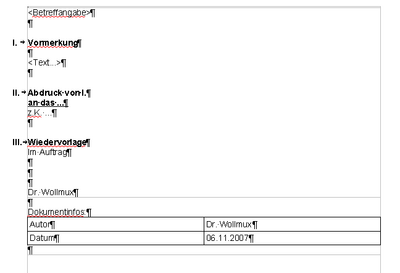
This preview contains after the last disposal point Resubmission a text part with information about the document and a table, which should only be printed in the draft. However, the problematic text part has now been packed into a text area (gray border around the text part) with the name "Document info".
When printing the original, all contents to be hidden are correctly hidden.
Within a block for print control: With the The buttons to control the printing of individual blocks any text passages can be hidden or shown when printing the Content based directives, even if they are not directly below a heading but e.g. in a separate text frame. If the problematic content is located in such a print block, the area name must be structured according to the following system:
<any name> GROUPS '<SLV_visibility group>'
Here you can put any name in the place <any name>. In the place <SLV_visibility group> must be entered one of the following values:
- SLV_AllVersions: Analogous to the print block "Always print", this area is printed in all printouts.
- SLV_NotInOriginal: Analogous to the "Not in Original" print block, this area is printed in all printouts except the original.
- SLV_OriginalOnly: Analogous to the "Original Only" print block, this area is printed in the original only.
- SLV_DraftOnly: Analogous to the "Draft Only" print block, this area is printed in draft only.
- SLV_CopyOnly: Analogous to the "Copy Only" print block, this area is printed in all printouts except the original and the draft.
In this way you define a text area with name extension GROUPS, which is controlled by above special visibility groups. The visibility groups are automatically set by WollMux when printing, and thus control the visibility of the text area.
Printing Content based directives
Content based directives can be printed via the Writer toolbar "Standard" → button "Print file directly".
or printed via the Writer menu "File" → "Print".
The "Wollmux Comfort Print" dialog appears if Content based directives elements are present.
Printouts: The "Printouts" column lists the headers of all recognized disposal points. Each listed supply line counts up the copy counter of this disposal point by one.
Copies: In the column "Copies" you can set for each printout how often this printout should be printed. Since normally a copy is needed for each supply line of the disposition point, the copy counter is preset with the number of the corresponding supply lines. To prevent a copy from being printed, set the corresponding copy counter to 0.
Example: Printing an internal letter
Via the toolbar "Print file directly" or the menu item "Print" the dialog "Wollmux Comfort Print" appears.
After pressing the button "Print all printouts" you will get the following three printouts. Each line marked as a feed line counts as one printout. Put away also counts as one printout. If an expression is not required, the number must be set accordingly. Fade in and fade out e.g. for "I.A. Name" can be set via The buttons to control the printing of individual blocks.
|
Printout can also be printed individually using the "Print" button to the right of "III. Put away" |
Printout can also be printed individually using the "Print" button to the right of "II. Imprint of I." |
Printout can also be printed individually using the "Print" button to the right of "I. Preview" |
Example: Printing an external letter
Via the toolbar "Print file directly" or the menu item "Print", the dialog "Wollmux comfort print" appears.
After pressing the button "Print all printouts" you get the following four printouts. Each line marked as a feed line counts as one printout. WV (resubmission) also counts as one printout. If an expression is not required, the number must be set accordingly. Fade in and fade out e.g. for "I.A. Name" can be set via The buttons to control the printing of individual blocks.
|
Expression "III. WV....." |
Expression "II. imprint of I." |
Expression "II. imprint of I." |
Expression "I. Original" |
|---|---|---|---|
|
Printout can also be printed individually using the "Print" button to the right of "III. WV ....." |
Printout can also be printed individually using the "Print" button to the right of "II. imprint of I." |
Printout can also be printed individually using the "Print" button to the right of "II. impression of I." |
Printout can also be printed individually via the "Print" button to the right of "I. Original" |
Basic information about Content based directives Print
- In the case of an External Letter, the I. is displayed as "I. Original", otherwise the description from the disposition is displayed (e.g. preview or transcript).
- If no paragraph is marked as a supply line in a disposition, the print counter is initialized with 1.
- All paragraphs marked as feed line are displayed as dropdown to the respective order, with the corresponding number of printouts.
- Each printout can be printed individually with a "Print" button next to the corresponding order.
- The sum of all printouts is displayed as a "read only" field.
- All printouts can be printed using the "Print All" button.
- Another printer can be selected or settings can be changed using the "Print Settings" button.
Collect printouts in a PDF
This alternative to printing creates a PDF document containing all printouts. This is similar to printing all documents with a "PDF printer" and then combining the created PDF documents into one document.
Appendix details
Here is a summary of the behavior of all the buttons in the various possible situations:
|
Situation/Button |
Insert digit |
Imprint |
Feed line |
|---|---|---|---|
|
1. The cursor is on body text and does not highlight any area |
1a) The Roman numeral is inserted on the left side of the paragraph where the cursor is (for ranges, at the start position of the cursor) and formatted as a disposal point (bold). The cursor remains unchanged. |
1b) At the cursor position (For ranges before the start position of the cursor), a new paragraph is inserted and formatted as the disposal point with the text "Imprint of I. ..." is formatted. This is followed by an additional paragraph after the impression. In any case, the cursor is then at the beginning of the first paragraph after the impression. |
1c) The paragraph in which the cursor is located is formatted as a lead-in line and the cursor remains unchanged. |
|
2. The cursor is on a disposal point and does not mark a range |
2a) The Roman numeral of the disposal point is deleted and the paragraph format is reset to "body text". The cursor remains unchanged. |
2b) At the end of the paragraph of the disposal point, the impression is inserted (except for the position) as described in 1b). |
2c) The disposition point in which the cursor is located is formatted as a disposition with feed line and the cursor remains unchanged. |
|
3. The cursor is on an impression and does not mark an area |
3a) The impression is removed as described in 3b). |
3b) The complete paragraph of the impression is deleted. If the impression was followed by a blank line, this is also deleted. The cursor is then at the end of the previous line of the impression. |
3c) After the impression, a new blank line is inserted and this is formatted as a lead line. The cursor is at the beginning of the new lead line. |
|
4. The cursor is on a disposal point with supply line and does not mark an area |
4a) The digit is removed and the paragraph is marked as a supply line. The cursor remains unchanged. |
4b) At the end of the paragraph of the disposal point with supply line, the impression is inserted (except for the position) as described in 1b). |
4c) The lead is removed, in which the paragraph is formatted as a normal disposal point. The cursor remains unchanged. |
|
5. The cursor is on a lead line and does not highlight a range |
5a) The Roman numeral is inserted in the paragraph where the cursor is (for ranges, at the start position of the cursor) and the paragraph is marked as a disposition point with feed line. The cursor remains unchanged. |
5b) The impression is inserted as described in 1b). |
5c) The lead-in line is removed, in which the paragraph format is reset to "body text". The cursor remains unchanged. |
|
6. The cursor extends over several lines, marking different elements (disposal points, lead lines, imprints, disposal points with leads). At least one paragraph with the type of element to be inserted is present in the selection: |
6a) All contained disposal points with leads are removed as described in 4a). All contained casts are removed as described in 3b). All other contained disposal points are removed as described in 2a). The cursor remains unchanged. |
6b) All contained casts are removed as described in 3b). The cursor remains unchanged. |
6c) All contained lead lines are removed as described in 5c). The cursor remains unchanged. |
|
7. The cursor extends over several lines, marking different elements (disposition points, lead lines, casts, disposition points with leads). However, no paragraph with the type of element to be inserted is present in the selection: |
7a) The paragraph in which the range start position is located is formatted as an avail point (for body text 1a) and for lead-in lines 5a)). The cursor remains unchanged. |
7b) At the start position of the range, the the impression is inserted (for body text and feed lines 1b), for for disposal points 3b)). |
7c) All body text paragraphs are treated as in 1c), all casts are ignored, and all other disposition points are treated as 2c). The cursor remains unchanged. |
